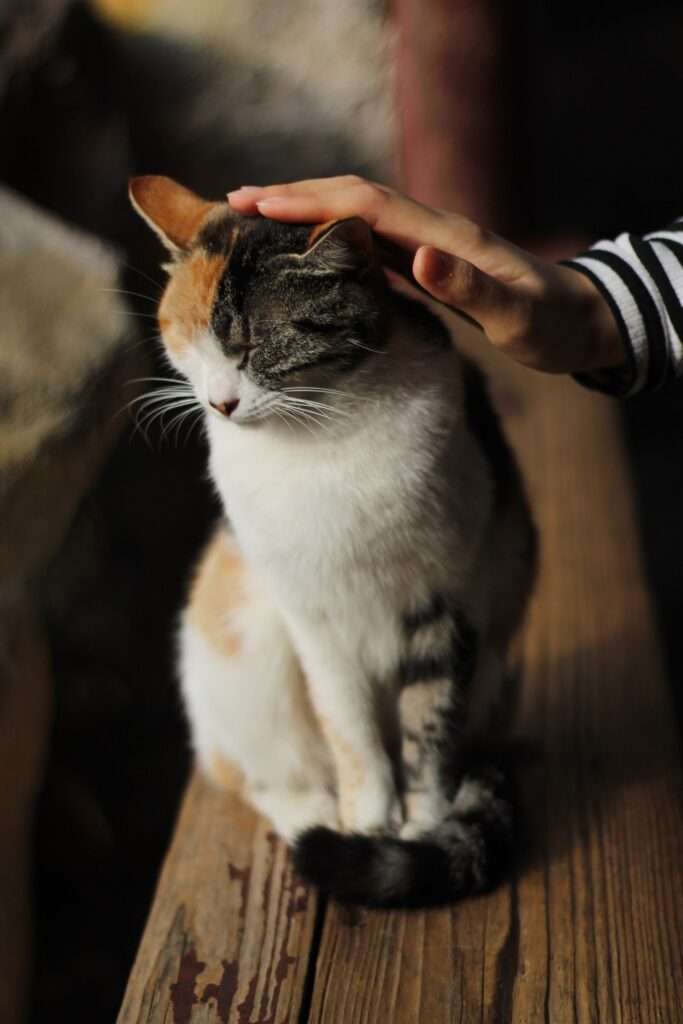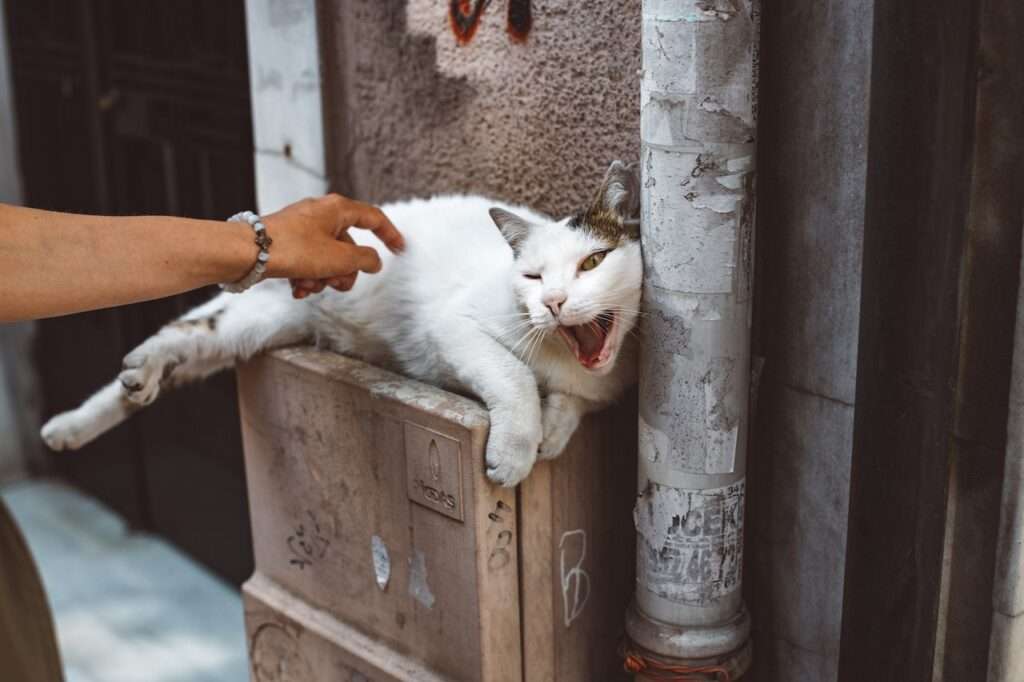Where to Pet a Cat Like a Pro: The Ultimate Guide
Are you a new cat parent? Or maybe you’re just looking to improve your relationship with your feline friend? One of the most important things to understand is how to pet a cat properly. Bonding with your cat through petting is a wonderful way to show them affection.
However, it’s crucial to understand the appropriate ways and areas to pet your feline companion, ensuring their comfort and safety. This all-inclusive guide is designed to provide you with everything you need to know about petting a cat, from the ideal places to pet them to the areas you should avoid, and even tips for petting shy or anxious felines.
We’ll also provide dos and don’ts for petting cats, as well as tips for understanding your cat’s individual preferences. By the end of this guide, you’ll be a pro at petting cats and your feline friend will thank you for it.
Understanding a Cat’s Body Language

Cats communicate in a variety of ways, and one of the most important ways they communicate is through body language. A cat’s posture, facial expressions, and tail movements can all give clues about its mood and how it’s feeling. It’s essential to understand a cat’s body language to know when it’s appropriate to pet them and when it’s not.
Here are some tips on how to read a cat’s body language:
- Look at the ears: A cat’s ears are one of the most expressive parts of its body. If a cat’s ears are forward and slightly turned to the side, it’s a sign that it’s relaxed and happy. However, if the ears are flat against the head, it’s a sign that the cat is feeling defensive or aggressive.
- Watch the tail: A cat’s tail can be a great indicator of its mood. If the tail is upright and gently curved at the top, it’s a sign that the cat is feeling happy and content. However, if the tail is tucked between the legs, it’s a sign that the cat is feeling scared or anxious.
- Pay attention to the eyes: A cat’s eyes can also give clues about its mood. If the cat’s eyes are half-closed, it’s a sign that the cat is feeling relaxed and content. However, if the cat’s pupils are dilated, it’s a sign that the cat is feeling scared or agitated.
By understanding a cat’s body language, you can determine whether it’s appropriate to pet them and where it’s safe to do so. In the next section, we’ll explore the different areas of a cat’s body that can be petted.
The Best Places to Pet a Cat
Now that you understand a cat’s body language, it’s time to talk about the best places to pet them. Cats have sensitive skin and can be particular about where they like to be touched, so it’s important to stick to the areas where they enjoy being petted.
Here are some areas that cats typically enjoy being petted:
- Head and Face: Cats enjoy being petted on the head and face, particularly around the cheeks and chin. Gently stroking the cat’s head and face can be incredibly soothing for them.
- Neck and Shoulders: Cats also enjoy being petted on the neck and shoulders. Gently stroking this area can help relax them and make them feel loved.
- Back and Sides: Cats enjoy being petted along the back and sides. Using a gentle, slow stroking motion can help soothe them and create a sense of relaxation.
- Belly and Tail: While some cats enjoy being petted on their belly and tail, it’s important to approach these areas with caution. Some cats are sensitive in these areas, and if they feel threatened, they may lash out. If you do pet your cat’s belly or tail, make sure to do so gently and slowly.
Areas to Avoid When Petting a Cat
While there are plenty of areas on a cat’s body that are safe and enjoyable to pet, there are also areas that should be avoided. Cats are sensitive creatures and can become uncomfortable or even agitated if they’re touched in certain areas.
One area to avoid when petting a cat is the stomach. While some cats may enjoy a gentle rub on the belly, many cats are sensitive in this area and may become defensive or even aggressive if they’re touched there. Another area to avoid is the tail, as cats use their tails to communicate and may become upset if their tail is grabbed or pulled.
It’s also important to be mindful of a cat’s feet, as they can be sensitive and may be used for defense if the cat feels threatened. If you’re unsure about where to pet your cat, it’s always best to start with the areas that are generally safe, such as the head and neck. Watch your cat’s body language to see if they’re enjoying the experience, and adjust your approach accordingly.
Tips for Petting a Shy or Nervous Cat

Petting a shy or nervous cat can be challenging, but with patience and understanding, you can help them feel more comfortable and confident around you. Here are some tips for petting a shy or nervous cat:
- Approach them slowly and calmly, letting them sniff your hand first
- Let your cat come to you as cats generally enjoy being in control, so if they approach you themselves, it’s a sign that they’re comfortable with you
- Offer treats or toys to create a positive association with being petted
- Start by petting them on the head or cheeks, gradually working your way to other areas as they become more comfortable
- Pay attention to their body language and stop if they show signs of discomfort or anxiety
- Avoid sudden movements or loud noises, as these can startle and scare a shy or nervous cat
Remember, every cat is unique and may require different techniques for making them feel comfortable. By being patient and understanding, you can build a positive relationship with your shy or nervous cat.
The Dos and Don’ts of Petting a Cat
When it comes to petting a cat, there are certain dos and don’ts to keep in mind. Here are some guidelines for petting cats:
Dos:
- Approach the cat slowly and calmly
- Let the cat sniff your hand before petting them
- Stick to the areas where the cat enjoys being petted, such as the head, cheeks, and chin
- Watch the cat’s body language and stop if they show signs of discomfort or anxiety
- Offer treats or toys to create a positive association with being petted
Don’ts:
- Don’t grab or squeeze the cat
- Don’t pet them on the stomach or tail
- Don’t force them to be petted if they’re not interested
- Don’t make sudden movements or loud noises that could startle or scare the cat
- Don’t pet them too roughly or vigorously
By following these dos and don’ts, you can ensure that both you and your feline friend have a positive and enjoyable experience when petting.
Understanding Your Cat’s Preferences

Just like people, cats have their own unique preferences when it comes to being petted. Some cats love belly rubs, while others can’t stand them. Some cats enjoy being picked up and cuddled, while others prefer to be left alone. Understanding your cat’s preferences is key to creating a positive and enjoyable experience for both of you.
Pay attention to your cat’s body language and behavior when you pet them. Do they lean into your touch or pull away? Do they purr or hiss? These are all signs that can help you understand what your cat likes and doesn’t like.
It’s also important to remember that your cat’s preferences may change over time. They may develop new likes or dislikes as they age or have different preferences based on their mood or environment. By staying attuned to your cat’s body language and behavior, you can adjust your approach to petting to meet their changing needs.
Conclusion
Knowing where and how to pet a cat can make all the difference in creating a positive and enjoyable experience for both you and your feline friend. Remember, every cat is unique and may require different approaches to petting.
By understanding their body language, sticking to the areas where they enjoy being petted, and being mindful of their preferences and sensitivities, you can build a strong bond and create a happy and healthy relationship with your feline companion.
Frequently Asked Questions
Q: Can I pet a cat anywhere on their body?
A: No, not all cats enjoy being petted in certain areas. It’s important to understand where your cat likes to be petted and where they don’t. Generally, cats enjoy being petted on their head, chin, and cheeks, but may not enjoy being petted on their belly, tail, or feet.
Q: Is it okay to pet a cat’s whiskers?
A: No, it’s not recommended to pet a cat’s whiskers. Whiskers are very sensitive and serve as a sensory tool for cats. Petting their whiskers can cause discomfort and even pain for the cat.
Q: How do I know if my cat wants to be petted?
A: Look for signs of relaxation and enjoyment from your cat. A relaxed body posture, purring, and slow blinking are all signs that your cat is enjoying being petted. However, if your cat is tense, hissing, or swatting at you, it’s best to back off and give them some space.
Q: Can I pet a cat while they’re eating or sleeping?
A: No, it’s best to avoid petting a cat while they’re eating or sleeping. This can startle them and may cause them to become defensive or aggressive. Wait until your cat is awake and alert before attempting to pet them.
Q: Should I pet my cat’s belly?
A: It depends on the cat. Some cats enjoy belly rubs, while others do not. It’s important to approach your cat slowly and gently and watch for signs of discomfort or agitation. If your cat seems relaxed and comfortable, you can try petting their belly.
Q: Can I pet a cat’s ears?
A: It’s generally not recommended to pet a cat’s ears. Cats’ ears are also very sensitive and petting them can cause discomfort or even pain for the cat.
Q: How much pressure should I use when petting a cat?
A: Use gentle pressure when petting a cat. Avoid using too much force or pressure, as this can cause discomfort or pain for the cat.
Q: Is it okay to pet a cat’s tail?
A: Some cats may enjoy having their tail petted, while others may not. It’s important to watch for signs of discomfort or agitation, such as twitching or lashing of the tail.
Q: Can I pet a cat’s paws?
A: It’s generally not recommended to pet a cat’s paws. Some cats may not like having their paws touched, and it can be uncomfortable for them.
Q: How often should I pet my cat?
A: It depends on the cat and their individual preferences. Some cats may enjoy being petted frequently, while others may prefer less interaction. It’s important to pay attention to your cat’s body language and behavior to determine when they want to be petted and when they want to be left alone.
References
- “How to Pet a Cat.” Daily Paws. https://www.dailypaws.com/cats-kittens/cat-safety-tips/how-to-pet-a-cat
- “How to Pet a Cat.” Wikihow. https://www.wikihow.com/Pet-a-Cat
- “Where to Pet a Cat.” Dutch.com. https://www.dutch.com/blogs/cats/where-to-pet-cat
- “How Do Cats Like to Be Petted?” Purina Canada. https://www.purina.ca/articles/cat/behaviour/how-do-cats-be-petted
- “How to Pet a Cat.” Comfort Zone. https://www.comfortzone.com/behavior-blog/cat-behavior/how-to-pet-a-cat





